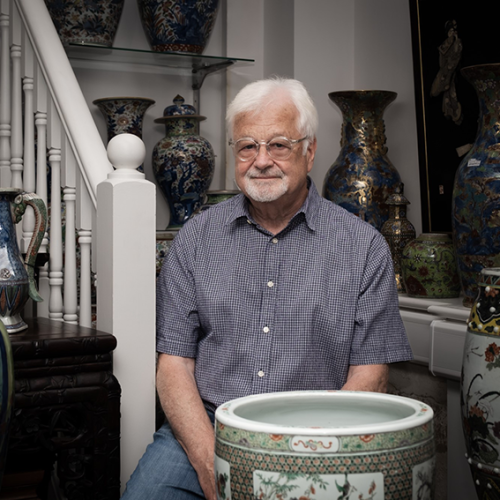

The BADA is delighted to introduce the new ‘Meet the Dealer’ series. Get to know the people and personalities that make the BADA, as we delve into their businesses, passions, and insights on buying and collecting. Through a series of interviews, we uncover their stories and discover what drives them in the world of art and antiques.
Kevin Page
Kevin Page Oriental Art Ltd
Founded in 1968 and located in the renowned Camden Passage in Islington in London, Kevin Page Oriental Art specialises in Japanese Meiji-period (1868 - 1912) art and ceramics including fine Satsuma ware, bronzes and Okimono, multi-metal ware, Cloisonneware, Imari ware, embroideries, furniture and much more.
Could you tell us about your favourite piece currently in stock and what makes it so special? It’s hard to choose just one piece to call a favourite. It is like asking a film buff for their favourite movie or a music fan, for their favourite album. There are so many wonderful pieces to choose from.
It’s hard to choose just one piece to call a favourite. It is like asking a film buff for their favourite movie or a music fan, for their favourite album. There are so many wonderful pieces to choose from.
If I had to choose just one piece right now, it would most likely be a recent addition to the collection, a Monumental Iron and multi-metal dish depicting a Temple Guardian.
The size and scale of this piece is quite something but it is when you move closer that you can really appreciate the masterful craftsmanship and imagination of the artists, Isshinsai and Tojin.
The dish shows a fearsome statue of a Nio, (Temple Guardians are often found at the entrances to Shrines and Temples across Japan to scare off evil spirits) and on closer inspection you can see a family of Sparrows have made a nest in the mouth of the figure. In fact, the scene is full of symbolism. Temple Guardians with Open Mouths represent new life, (which ties in nicely with the family of birds that have made the mouth their home) and in Japanese culture, Sparrows represent longevity, perseverance and hard work. For me, it is the humorous dichotomy between the fury of the Temple Guardian and the fragility of the nest of fledglings that makes this piece even more special. We actually wrote a blog about this piece. You can read it here:
https://kevinpage.co.uk/news-and-blog/a-monumental-multi-metal-mythological-meiji-era-master-piece/
Could you tell us about a recent visit to a gallery, exhibition or fair you have visited and enjoyed?
At the end of last year we took the (grand)children to the Young V&A in East London to visit the “Japan: From Myths to Manga” exhibition. Geared towards the younger generation, it was a really fun and engaging trip through Japan, exploring how landscape and folklore have influenced Japanese art, technology and design. So many popular video games, animated films, comic books and contemporary architectural designs have been inspired by the same characters and scenes that appear throughout our collection of Japanese Meiji-era works of art. It runs until September this year so well worth a visit for anybody with children keen to learn more about Japanese mythology.
Could you tell us three top tips for what to look for when buying Satsuma ware?
One of the most popular categories on our website is Japanese, late 19th Century Satsuma ware. Satsuma ware is a distinctive looking form of earthen ware pottery originating from the Satsuma Province in Southern Kyushu. When buying Satsuma ware we would recommend the following three tips:
1. Look for fine detailed miniature painting with a good range of colours. The very finest on-glaze painting will almost look like watercolour with layers of different colours blended together. Faces should be fine and birds and flowers should be more realistic than stylised. Very fine painting and restraint is a hallmark of some of the best artists such as Yabu Meizan, Sozan and Ryozan. They would often resist covering the whole piece in pattern and use the negative space to enhance their design. Earlier pieces tend to have a more two dimensional look to landscape image. This is because they were greatly inspired by the popular Japanese prints of the day.
2. Marks and signatures started becoming common from around 1870, so very early pieces may actually be unmarked. If your mark is written in the English language and particularly if it reads “Made in Japan”, this will unfortunately most likely be a very late piece. You will very often see a circle mark with a cross in it on the underside of a piece or sometimes incorporated as part of the design. This is the Shimazu Mon, which is the crest of the family that ruled Satsuma.
3. Finally and perhaps most importantly our advice is to follow your heart. Do not just go looking for the well-known artists. Step back and marvel at how a human hand could have painted these artworks. Look for pieces that appeal to you personally and then after that assess the detail, design, colours and condition. It is a great time to start collecting Japanese export Satsuma ware. It is possible to find genuine Meiji-Period, (1868-1912) pieces for less than one hundred pounds and fine quality objects will likely become very profitable investments for future years.
You can read our article “An introduction to collecting Satsuma ware by clicking here.

